CCNP Enterprise: Advanced Routing (Version 8.0) – OSPF Exam
1. Which two commands will configure OSPFv2 MD5 authentication on a router interface? (Choose two.)
- default-information originate
- area 0 authentication message-digest
- ip ospf authentication message-digest
- router ospf 10
- ip ospf message-digest-key 1 md5 CISCO-ABC
- ip ospf priority 255
2. At which OSPF state are neighbor routers converged and able to exchange routing updates?
- ExStart
- Exchange
- Two-Way
- Full
3. What will an OSPF router prefer to use first as a router ID?
- a loopback interface that is configured with the highest IP address on the router
- the highest active interface IP that is configured on the router
- any IP address that is configured using the router-id command
- the highest active interface that participates in the routing process because of a specifically configured network statement
4. What are three entries that are displayed by the show ip ospf neighbor command? (Choose three.)
- the OSPF process ID used to establish the adjacency
- the OSPF state of each interface
- the route metric and neighbor next hop address
- the router ID of the neighboring routers
- the OSPF area number shared by the neighbor routers
- the IP address of the neighbor router interface to which this router is directly connected
5. Refer to the exhibit. Which three statements describe the results of the OSPF election process of the topology that is shown in the exhibit? (Choose three.)
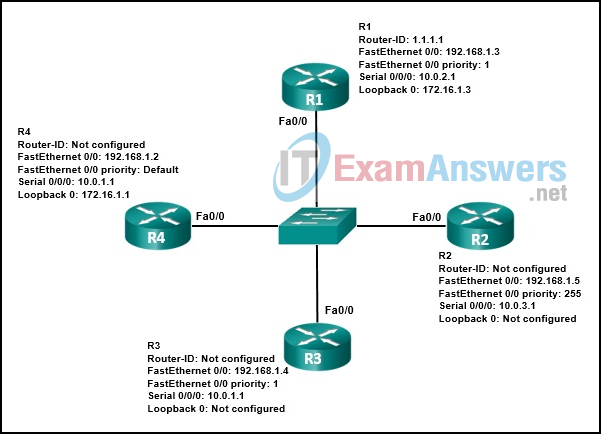
- The router ID on R2 is the loopback interface.
- R2 will be elected DR.
- R3 will be elected BDR.
- R1 will be elected BDR.
- The R4 router ID is 172.16.1.1.
- The R4 FastEthernet 0/0 priority is 128.
6. In which two situations would an OSPF point-to-multipoint configuration be used? (Choose two.)
- Frame Relay WAN
- loopback network
- Layer 2 VPN
- ARP-based LAN
- multiaccess LAN
7. Refer to the exhibit. OSPF is used in the network. Which path will be chosen by OSPF to send data packets from Net A to Net B?
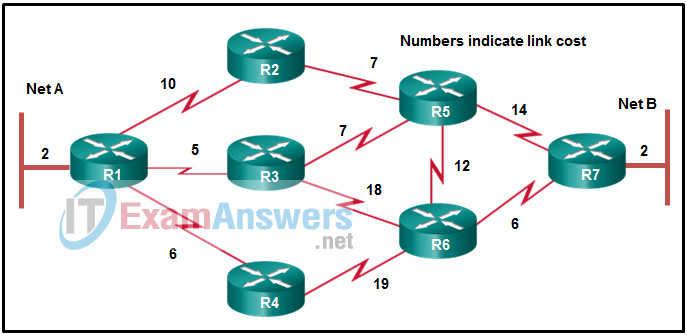
- R1, R3, R5, R7
- R1, R3, R5, R6, R7
- R1, R3, R6, R7
- R1, R4, R6, R7
- R1, R2, R5, R7
8. Which OSPF router or routers would require the following command to define a stub area?
router(config-router)# area [ area-id ] stub
- only the ASBR attached to the stub area
- only the ABR for the stub area
- all routers in the stub area
- only the DR and BDR routers in the stub area
9. A network engineer new to a company notices that a particular Layer 3 device participating in routing OSPF networks has an interface the engineer has not seen before in the output of the show ip ospf interface brief command. The interface is listed as VL0 and has a state of P2P with an OSPF neighbor. Which OSPF feature is the company using?
- a virtual interface
- a summarization of OSPF virtual interfaces
- an OSPF VPN
- a virtual link
10. What are the only two roles that permit an OSPF router to be configured for summarization? (Choose two.)
- designated router
- area border router
- backbone router
- autonomous system boundary router
- internal router
11. Which three statements describe features of the OSPF topology table? (Choose three.)
- The topology table contains feasible successor routes.
- Its contents are the result of running the SPF algorithm.
- After convergence, the table only contains the lowest cost route entries for all known networks.
- When converged, all routers in an area have identical topology tables.
- It is a link-state database that represents the network topology.
- The table can be viewed via the show ip ospf database command.
12. Which type of OSPF LSA represents an external route and is propagated across the entire OSPF domain?
- type 1
- type 2
- type 3
- type 4
- type 5
13. Refer to the exhibit. Why are routers R1 and R2 not able to establish an OSPF adjacency?
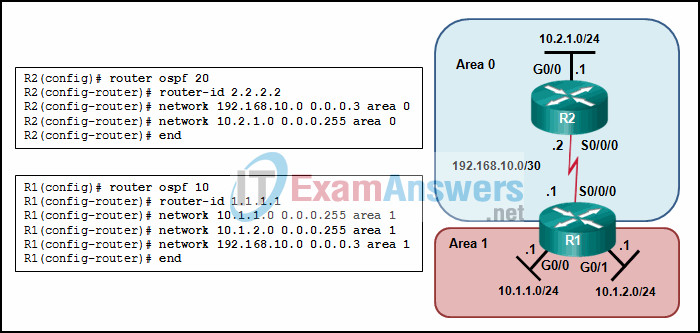
- A backbone router cannot establish an adjacency with an ABR router.
- The router ID values are not the same in both routers.
- The process numbers are not the same in both routers.
- The serial interfaces are not in the same area.
14. Refer to the exhibit. A company uses OSPF as its internal routing protocol. No routing protocol is used between the company and the ISP. The network administrator enters the following command on the router that connects to the ISP.
ip route 0.0.0.0 0.0.0.0 S0/0/0 120
The router does not show a default route and packets that are destined for noncompany networks are being dropped. What is the problem?
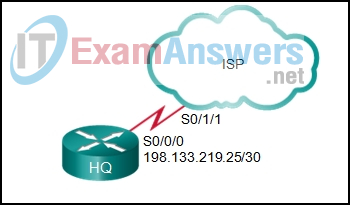
- There is a problem with the link.
- The next-hop argument should be used instead of the exit-interface argument.
- The administrative distance is too high.
- A network statement is missing from router configuration mode.
- The wrong interface is used in the command.
15. What are two reasons that will prevent two routers from forming an OSPFv2 adjacency? (Choose two.)
- mismatched OSPF Hello or Dead timers
- use of private IP addresses on the link interfaces
- one router connecting to a FastEthernet port on the switch and the other connecting to a GigabitEthernet port
- mismatched subnet masks on the link interfaces
- a mismatched Cisco IOS version that is used
16. A network engineer is troubleshooting convergence and adjacency issues in an OSPFv2 network and has noted that some expected network route entries are not displayed in the routing table. Which two commands will provide additional information about the state of router adjacencies, timer intervals, and the area ID? (Choose two.)
- show ip ospf interface
- show running-configuration
- show ip route ospf
- show ip protocols
- show ip ospf neighbor
17. Refer to the exhibit. A network administrator has configured OSPFv2 on the two Cisco routers but PC1 is unable to connect to PC2. What is the most likely problem?
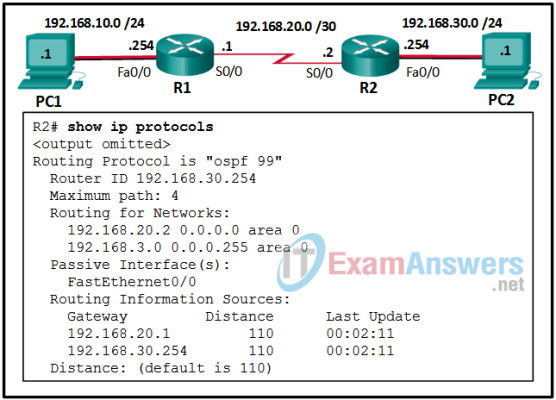
- Interface S0/0 is configured as a passive-interface on router R2.
- Interface Fa0/0 is configured as a passive-interface on router R2.
- Interface Fa0/0 has not been activated for OSPFv2 on router R2.
- Interface s0/0 has not been activated for OSPFv2 on router R2.
18. Refer to the exhibit. A network administrator has configured OSPFv2 on the two Cisco routers as shown. The routers are unable to form a neighbor adjacency. What should be done to fix the problem?

- Add the command network 192.168.20.1 0.0.0.0 area 0 on router R1.
- Remove the FastEthernet0/0 passive interface configuration on router R1.
- Change the IP address on S0/0 of router R2 to 192.168.20.2.
- Add the command network 192.168.30.0 0.0.0.255 area 0 on router R1.
19. Which OSPFv3 LSA type is used by ASBRs to announce routes learned through redistribution from other routing protocols?
- type 3
- type 4
- type 5
- type 7
20. What is a purpose of the OSPFv3 type 8 and type 9 LSAs?
- advertise default and external routes learned from other protocols
- eliminate the need for SPF calculations when interface addresses are added or changed
- allow area routers to locate ASBRs in other areas
- advertise NSSA LSAs for redistributed routes in an area
21. What are two features of OSPFv3? (Choose two.)
- IPv6 is used to transport OSPFv3 messages for IPv4 and OSPFv3 messages for IPv6.
- By default, OSPFv3 enables both IPv4 and IPv6 addressing on an interface.
- A 32-bit router ID is used when configuring OSPFv3 for IPv4 and IPv6.
- A 32-bit router ID is used for OSPFv3 for IPv4 and a 128-bit router ID for OSPFv3 for IPv6.
- IPv4 is used to transport OSPFv3 IPv4 messages and IPv6 is used to transport OSPFv3 IPv6 messages.
22. A network technician is configuring OSPFv3 with address families on a Cisco router. To verify the configuration the technician issues the show ospfv3 interface brief command. Which three items of information would the technician expect to be displayed? (Choose three.)
- the state of OSPFv3 neighbor routers
- the associated process ID
- the address family (IPv4 or IPv6)
- the configured hello timer intervals
- the OSPFv3 area ID
- the router IDs of OSPFv3 neighbor routers
23. What is described by the interarea prefix LSAs sent by an OSPFv3 ABR?
- prefixes of link-local routes in the OSPFv3 area
- routes that belong to other areas in the OSPF domain
- the segment designated router ID
- autonomous area address family information
24. Under which configuration mode are OSPFv3 summarization commands issued?
- interface configuration mode
- global configuration mode
- user configuration mode
- address-family configuration mode
25. An administrator attempts to change the router ID on a router that is running OSPFv3 by changing the IPv4 address on the router loopback interface. Once the IPv4 address is changed, the administrator notes that the router ID did not change. What two actions can the administrator take so that the router will use the new IPv4 address as the router ID? (Choose two.)
- Copy the running configuration to NVRAM.
- Clear the IPv6 OSPF process.
- Shut down and re-enable the loopback interface.
- Reboot the router.
- Disable and re-enable IPv4 routing.
26. Refer to the exhibit. An administrator is trying to configure R1 to run OSPFv3 but the neighbor adjacency is not forming with the router connected to Fa0/0. What is the cause of the problem?

- A link-local address has not been configured on interface FastEthernet0/0.
- The OSPF process ID and area values are backwards in the interface configuration.
- FastEthernet0/0 has been configured as a passive interface.
- No router ID has been configured.
27. Refer to the exhibit. A network administrator is configuring OSPF for R1 and R2, but the adjacency cannot be established. What is the cause of the issue?
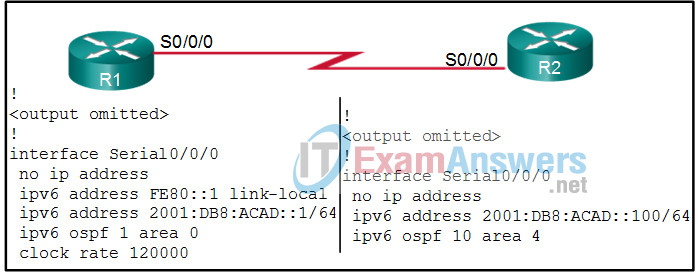
- The area ID is misconfigured.
- The IP address on router R2 is misconfigured.
- The process ID is misconfigured.
- The interface s0/0/0 on router R2 is missing a link-local address.
28. Refer to the exhibit. Directly connected networks configured on router R1 are not being shared with neighboring routers through OSPFv3. What is the cause of the issue?
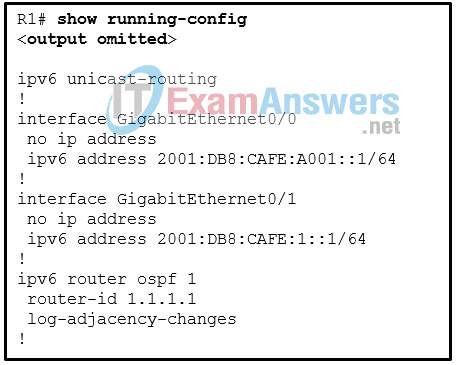
- There are no IPv4 addresses configured on the interfaces.
- IPv6 OSPF routing is not enabled.
- The routes are not enabled in the OSPF advertisement.
- There are no network statements for the routes in the OSPF configuration.
29. Which command is used to enable OSPFv3 and address families on an interface?
- R1(config-router)# network [ wildcard_mask | prefix-length ] area area-id
- R1(config-if)# ospfv3 pid { ipv4 | ipv6 } area area-id
- R1(config-if)# { ipv4 | ipv6} ospfv3 area area-id
- R1(config-if)# address-family { ipv6 | ipv4 } unicast
30. Refer to the exhibit. A network technician is troubleshooting missing OSPFv3 routes on a router. What is the cause of the problem based on the command output?

- The dead time must be higher than 30 for all routers to form neighbor adjacencies.
- The neighbor IDs are incorrect. The interfaces must use only IPv6 addresses to ensure fully synchronized routing databases.
- The local router has formed complete neighbor adjacencies, but must be in a 2WAY state for the router databases to be fully synchronized.
- There is a problem with the OSPFv3 adjacency between the local router and the router that is using the neighbor ID 2.2.2.2.
31. The OSPF hello timer has been set to 15 seconds on a router in a point-to-point network. By default, what is the dead interval on this router?
- 15 seconds
- 60 seconds
- 30 seconds
- 45 seconds
32. Refer to the exhibit of the routing table from a router that is a backbone router and the ABR router for area 1. How will this routing table change, if any, if area 1 is configured as a stub area?
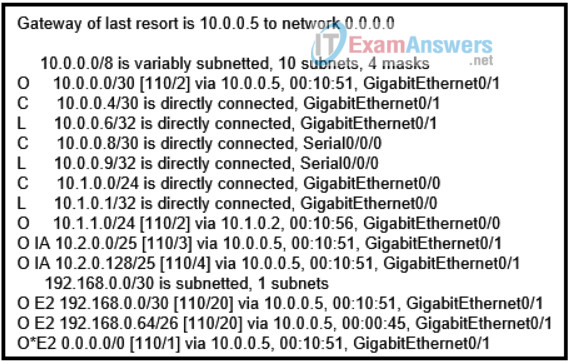
CCNP Enterprise: Advanced Routing ( Version 8.0) – OSPF Exam 12
- Only the O E2 routes will be removed from the routing table.
- All of the O IA and O E2 routes will be removed from the routing table.
- Only the O IA routes and the two O E2 subnet routes to the 192.168.0.0 networks will be removed.
- None of the routes will be removed as a result of Area 1 and this ABR being configured as a stub area.
33. Which command is used to verify that OSPF is enabled and also provides a list of the networks that are being advertised by the network?
- show ip protocols
- show ip ospf interface
- show ip interface brief
- show ip route ospf
34. Refer to the exhibit. Which configuration on R1 would advertise a summary route of the two LANs to R2?
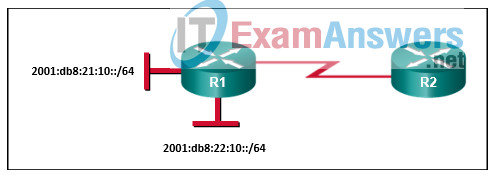
CCNP Enterprise: Advanced Routing ( Version 8.0) – OSPF Exam 22
- area 0 range 2001:db8:20::/44
- area 0 range 2001:db8:11::/48
- area 0 range 2001:db8:10::/44
- area 0 range 2001:db8:21::/48
